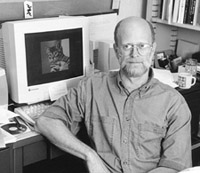Karl F. Canter

In Memoriam
1944-2006
Karl Canter, a pioneer of experimental positron physics and a professor at Brandeis University, died on September 24, 2006, after a long battle with cancer. He was 62 years old.
Canter began studying positrons (a positron is the antimatter twin of an electron) at Wayne State University, where he earned his doctorate in 1970. Following a post-doctoral position at University College, London, he came to Brandeis University in 1972 and began a long and productive collaboration with Stephan Berko (deceased) and Allen P. Mills (now at U.C. Riverside). Canter's crucial contribution was a practical way of slowing down the high energy positrons emitted by radioactive sources to make a focused and controlled beam of slow positrons. This was the starting point for a series of diverse experiments of increasing precision and sophistication. These ranged from detecting Lyman alpha radiation and measuring the Lamb shift in the positronium atom (an electron and a positron in orbit about each other) to constructing the first positron reemission microscope. In 1978 he was awarded a Sloan Fellowship for Basic Research which, according to the Sloan Foundation, honors "the most creative young researchers."
In later years Canter's research interests extended to biophysics. He became fascinated by an unusual organism, the Magnetotactic Multicellular Prokaryote (MMP). The MMP is a permanent aggregation of single bacterial cells, linked together and functioning as one organism. Canter, working with microbiologist Inga Mahler, studied the singular behavior of this organism and in diverse magnetic fields, reported on its rare explosive excursions and published a detailed analysis of MMP motility in applied magnetic fields. His group was also the first to document the observation that this multicellular organism reproduces by binary fission.
His long-time colleague Allen Mills writes: "Karl F. Canter was a man of unconventional thought, who through intuition and analogy took the lead on fascinating projects from his early studies of antimatter to his latest work on the strange collective behaviors of magnetic bacteria. He is best known for discovering the excited states of the positronium atom, for the first widely used and practical device for creating slow positrons, for delineating the mobility edge of positrons in liquid helium, for measurements revealing the surface structure of compound semiconductors via positron diffraction and for making the first positron reemission microscope. During his last difficult years, Canter’s calm philosophy, his friendliness and quiet humor, his enthusiasm for his grandchildren and his newfound interest in bacteria, will be remembered as noble examples for his friends and colleagues."
Professor Leonard Roellig at Wayne State University, who was Canter’s supervisor for his doctoral research, adds: "Karl Canter was a true scientist. Albert Einstein once said curiosity is more important than knowledge. Karl had both. He was one of the early pioneers to study how the positron, the anti-particle of the electron, interacted with matter. His fascination with the unknown made him a great teacher, imparting his sense of curiosity and knowledge to his students."
At Brandeis, Professor Canter served as department chair and also as a member of the Faculty Senate. He was a passionate teacher and educator, and students came to him and maintained relationships with him long after they went on to their own careers. He cared deeply about the honor and celebration due each individual student, and they held him in equal esteem and affection. At his 60th birthday party, students (many now full professors) came from as far a field as Texas to attend.
He was also a gifted and eclectic musician, who played violin in the Detroit Youth Orchestra at age 9. Later he turned to classical guitar, rock guitar and sitar. As a young man, his rock and roll band played for the USO and in local pool halls in Detroit.
He leaves his wife of 42 years, Ann, his daughter Laura of Melrose, Masssachusetts and son Steven, of Forestville, California. He was the doting grandfather of Nick, Ben and Luke.
Sample of Publications
“Installation of a Kr Moderator in the High-Brightness Beam at Brandeis,” with D. Vasumathi, G. Amarendra and A.P. Mills. Jr., Appl. Surf. Sci. 85, 154 (1995).
“Low-energy Positron Diffraction from CdTe(110): A Minimum-variance R-factor Analysis,” with C.B. Duke, A. Paton, A. Lazarides and D. Vasumathi. Phys. Rev. B55, 11 (1997).
“Imaging Defects in Metals With a Positron Re-emission Microscope,” with R. Xie. Mater. Chem. and Phys. 52, 221 (1998).